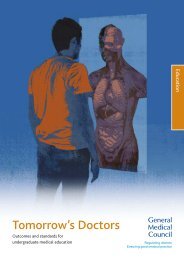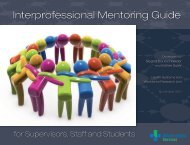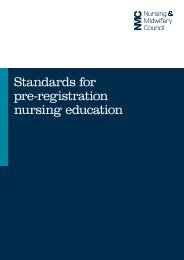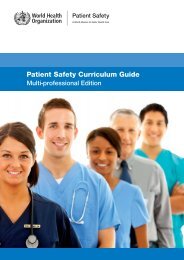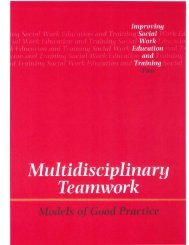Developing Interprofessional Education in health and social care ...
Developing Interprofessional Education in health and social care ...
Developing Interprofessional Education in health and social care ...
Create successful ePaper yourself
Turn your PDF publications into a flip-book with our unique Google optimized e-Paper software.
show how students created new <strong>in</strong>terprofessional knowledge from <strong>in</strong>teractionsbased on representation of authentic real life service user scenarios.Communication – synchronous <strong>and</strong> asynchronous – is mediated by the technology.Early use of video-conferenc<strong>in</strong>g <strong>and</strong> Voice over Internet Protocol (VOIP – such asSkype) was fraught by breakdowns <strong>and</strong> feedback. Students <strong>and</strong> teachers neededaccess to hardware <strong>and</strong> <strong>in</strong>ternet <strong>and</strong> although e-learn<strong>in</strong>g technologies considerablyimproved <strong>in</strong> quality <strong>and</strong> reliability, systems still „went down‟ occasionally. There mayhave been a disruptive time lag <strong>in</strong> communication if students <strong>and</strong> tutors were not onl<strong>in</strong>eat the same time. The dem<strong>and</strong>s of authenticity required a comb<strong>in</strong>ation ofdifferent technology tools, which students <strong>and</strong> teachers needed tra<strong>in</strong><strong>in</strong>g to use withdiffer<strong>in</strong>g degrees of effort <strong>and</strong> <strong>in</strong>terest.Although the quality of open source soft ware improved <strong>and</strong> costs of commercialprogrammes fell dur<strong>in</strong>g the years under review, develop<strong>in</strong>g <strong>and</strong> updat<strong>in</strong>g e-learn<strong>in</strong>gresources still required substantial <strong>in</strong>vestment <strong>in</strong> staff time. Some perceived a riskthat e-learn<strong>in</strong>g was <strong>in</strong> danger of becom<strong>in</strong>g a substitute for face-to-face learn<strong>in</strong>gbetween students from different professions with the attendant risk that e-technologies would determ<strong>in</strong>e course content <strong>and</strong> delivery. As the technology, <strong>and</strong>the language <strong>in</strong> which it was described, became more complex <strong>and</strong> esoteric, e-learn<strong>in</strong>g was <strong>in</strong> danger of becom<strong>in</strong>g less, not more, accessible for both students <strong>and</strong>teachers, more so when control was taken by technologists rather than by the<strong>in</strong>terprofessional teach<strong>in</strong>g team.Despite the widespread <strong>in</strong>terest that educational technologies prompted, from asurvey of e-learn<strong>in</strong>g <strong>in</strong> <strong>health</strong> sciences <strong>and</strong> practice <strong>in</strong> UK universities <strong>in</strong> 2006-8,Moule et al. concluded that exist<strong>in</strong>g technologies were under-exploited <strong>and</strong> underdeveloped.From his research <strong>in</strong>to how technology could help universities f<strong>in</strong>d newways to achieve aspirations, Bradwell (2009) found that it was most important – forlearners <strong>and</strong> teachers - to get the relationship <strong>and</strong> policy between the <strong>in</strong>stitutions<strong>and</strong> the technology “the right way round”. Technology may have the potential to beso powerful <strong>in</strong> IPE that it is driv<strong>in</strong>g the agenda. We trust not; like Oliver (2010) weprefer the metaphor of the weathervane, <strong>in</strong>dicat<strong>in</strong>g the direction <strong>and</strong> the force of thetrends <strong>in</strong> <strong>in</strong>terprofessional teach<strong>in</strong>g <strong>and</strong> learn<strong>in</strong>g.29




